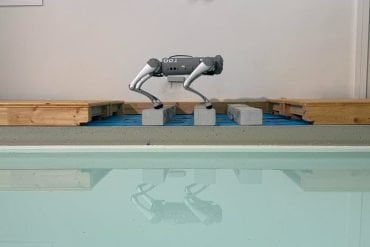Summary: Researchers shed light on how social relationships impact our physiological and psychological responses within interpersonal spaces (IPS). By examining reactions to friends occupying various positions around a person, they discovered significant differences in discomfort, heart rate, and heart rate variability, highlighting a nuanced understanding of IPS.
The study reveals that being close to friends triggers a parasympathetic, restful response, contrasting with the stress response elicited by strangers. These insights pave the way for developing communication methods tailored to social relationships, potentially enriching interpersonal interactions in diverse societal settings.
Key Facts:
- The presence of friends within one’s IPS affects physiological and psychological states, decreasing heart rate and increasing comfort compared to the presence of strangers.
- The study innovatively examines IPS from multiple relative positions, moving beyond the traditional front-and-back approach to encompass side profiles and eye contact.
- Findings suggest that social connections activate the parasympathetic nervous system, emphasizing the health benefits of close social bonds.
Source: University of Waseda
When we communicate with other people face-to-face, we do so by maintaining a certain physical distance from each other. This space surrounding our body while interacting is called the interpersonal space (IPS), and maintaining adequate IPS is crucial for better communication.
Many studies have investigated the psychological and physiological changes that occur based on the presence of another person in the IPS during face-to-face interactions.
These studies are based on the avoidance behavior that we experience when a stranger invades our IPS, which manifests in the form of increased heart rate and discomfort.
However, having a social relationship with a person, such as with a friend or a spouse, can influence this behavior.
Moreover, most studies have only examined IPS in front of or behind a person, using tasks such as a stopping task, wherein a stranger approaches or retreats from the IPS. They have not determined the shape of IPS by considering different relative positions around a person.
Addressing this gap, a team of researchers from Japan, led by Assistant Professor Kae Mukai from the Faculty of Science and Engineering at Waseda University, investigated the effect of social relationships on the physiological and psychological responses to the presence of another person in the IPS.
Dr. Mukai explains, “Considering a real-life situation in which acquaintances or friends are standing next to us, the threat level might be relatively low compared to when strangers are standing next to us.”
“Given the evidence that smaller IPSs may be formed with family and friends, psychological and physiological responses can differ. In this study, we uncovered these differences.”
The team also included Dr. Tomoko Isomura from Nagoya University, Dr. Ryoji Onagawa, and Professor Katsumi Watanabe from Waseda University.
Their findings were published in Scientific Reports.
The researchers used electrocardiogram (ECG) data to measure the changes in subjective discomfort, heart rate, and heart rate variability (HRV), which indicates parasympathetic activity or the “rest and digest” nervous response, of a person due to the presence of another person at various relative positions in the IPS.
They measured these changes during two tasks. In the first task, participants were paired with their friends in a static standing task, where a person stood 30 cm away from the other, with both hands behind their back, within the IPS for a minute.
There were eight relative positions in all: F-see, L-see, R-see, and B-see, as well as F-seen, L-seen, R-seen, and baseline. In the first case, participants stood face-to-face with their friend and looked at the center of their eyes.
In the next three cases, they looked at their friend’s left profile, right profile, and back, respectively, with their eyes fixed on the head.
On the other hand, the participants stood with their eyes fixed on the fixation point 30 cm in front of them while being seen at their left profiles, right profiles, and backs by their friend in F-seen, L-seen, and R-seen conditions, respectively.
Lastly, in the baseline condition, both persons were standing back-to-back, unable to see each other. In the second task, a cylindrical object with a height same as that of the person was placed at different positions in the IPS.
The experiments revealed that the greatest discomfort, the greatest decrease in heart rate, and the greatest increase in HRV occurred in the F-see condition.
The researchers attributed the decrease in heart rate and increase in parasympathetic activity to the presence of familiar people, as previous studies have shown that the presence of a friend or romantic partner activates parasympathetic activity.
Moreover, they found that heart rate only decreased in relative positions F-see and R-see. Additionally, no changes were observed during the task with the object.
These findings are inconsistent with previous studies, which report that sympathetic activity, or the “fight or flight” response, is activated when a stranger invades our personal space.
“Our study suggests that social relationships between two people influence our physiological responses during social interactions,” says Dr. Mukai.
“Our findings could help in the development of a society that makes life easier for a diverse range of people by introducing appropriate communication methods that vary according to changes in responses to the presence of others.”
About this social neuroscience research news
Author: Kae Mukai
Source: University of Waseda
Contact: Kae Mukai – University of Waseda
Image: The image is credited to Neuroscience News
Original Research: Open access.
“Electrocardiographic activity depends on the relative position between intimate persons” by Kae Mukai et al. Scientific Reports
Abstract
Electrocardiographic activity depends on the relative position between intimate persons
Interpersonal space (IPS) refers to the area surrounding the body in which we engage in social interactions while maintaining our comfort. Numerous previous studies have reported the psychological and physiological changes associated with the proximity of two people engaged in face-to-face interaction.
Currently, there is limited knowledge about how the relative position between two socially intimate individuals affects their psychological and physiological states. This research measured the subjective discomfort and electrocardiographic responses of participants when standing static at various relative positions.
The highest discomfort, lowest heart rate, and highest heart rate variability (HRV; parasympathetic activity index) were observed when the friend stood in the face-to-face position. Interestingly, heart rate also decreased when the friend stood on the right side, although HRV did not change.
We interpreted the results as suggesting that the presence of a familiar person elicits the electrocardiographic responses associated with an increase in parasympathetic activity.







